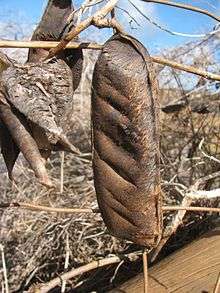Canavalia cathartica
| Canavalia cathartica | |
|---|---|
 | |
| Scientific classification | |
| Kingdom: | Plantae |
| (unranked): | Angiosperms |
| (unranked): | Eudicots |
| (unranked): | Rosids |
| Order: | Fabales |
| Family: | Fabaceae |
| Subfamily: | Faboideae |
| Tribe: | Phaseoleae |
| Genus: | Canavalia |
| Species: | C. cathartica |
| Binomial name | |
| Canavalia cathartica Thouars | |
| Synonyms | |
|
Canavalia glandifolia | |
Canavalia cathartica, commonly known as maunaloa,[1][2][3] is a species of flowering plant in the legume family, Fabaceae. It has a Paleotropical distribution,[1] occurring throughout tropical regions in Asia, Africa, Australia, and many Pacific Islands, and extending just into subtropical areas.[4]
Description
This plant is a biennial[5] or perennial[1] herb with thick, twining, climbing stems. The pinnate leaves are each divided into three papery leaflets which are generally oval in shape with pointed or rounded tips. They are up to 20 centimeters long by 14 wide, but usually smaller. The inflorescence is a raceme[5] or pseudoraceme[1] of several flowers. The flower has a bell-shaped calyx of sepals with two lips, an upper lip with two lobes and a lower lip with three teeth. The flower corolla is pink or purplish[5] with a white-spotted standard petal and two wing and two keel petals each roughly 3 centimeters long.[1] The fruit is an inflated, turgid legume pod up to 13.5 centimeters long by 4.5 wide.[1][5] The fresh, mature pod can weigh over 32 grams.[6] The hard, smooth seeds are reddish brown, darkening deeper brown, and reaching nearly 2 centimeters long by one wide.[1][5]
Ecology
In India this plant grows in mangroves. The seeds float on the water and land on coastal sand dunes, where the plant establishes. It is mat-forming and binds the sand, preventing erosion.[6]
This legume has a rich microbial ecology, including its nodal rhizobia, its arbuscular mycorrhizae, and an assemblage of endophytic fungi.[6] Common arbuscular fungal associates include the glomeromycetes Gigaspora albida, Acaulospora spinosa, and several species of Glomus, including G. aggregatum.[6] Microbial surveys have catalogued many endophytes in the plant, with varying assemblages in different habitat types. It houses the ascomycete Chaetomium globosum in its roots.[6] It also contains Colletotrichum dematium,[6] Aspergillus niger, A. flavus, Fusarium oxysporum, and Penicillium chrysogenum.[3] The microbial life hosted by the plant likely helps it persist in harsh coastal habitat.[6]
This species is the wild ancestor of Canavalia gladiata.[6]
Uses
The seeds and pods are used as famine foods in coastal India.[6][7] It is considered to be an underutilized wild plant with the potential to serve as a protein- and carbohydrate-rich food crop.[6] It has more protein than several other edible legumes such as pigeon pea, chickpea, and cowpea.[7] It grows rapidly, tolerates challenging habitat types such as dry, sandy, saline soils, and appears to be fairly pest-resistant.[6]
Like many legumes, C. cathartica contains antinutrients and requires some processing or preparation before it can be used for food. Antinutrients in the species include phenols, tannins, and lectins such as phytohaemagglutinin.[7] Pressure cooking can reduce antinutrients.[7] Roasting is somewhat less effective.[8]
In small-scale agriculture, farmers use this plant as green manure and mulch and host it in their fields for its nitrogen fixation. It grows easily on farmland in mangrove wetlands, it native habitat.[3] It is used as cattle fodder.[7] The stems with pods and leaves are fed to rabbits and hares.[6][7]
The plant grows in Micronesia, where the island inhabitants use it as an herbal remedy for conditions such as cough.[9]
In Hawaii, where it is a non-native and invasive species, its showy flowers and large seeds are used in leis.[10]
References
| Wikimedia Commons has media related to Canavalia cathartica. |
- 1 2 3 4 5 6 7 Canavalia cathartica. Flora of the Hawaiian Islands. Smithsonian National Museum of Natural History.
- ↑ Canavalia cathartica. Integrated Taxonomic Information System (ITIS).
- 1 2 3 Anita, D. D. and K. R. Sridhar. (2009). Assemblage and diversity of fungi associated with mangrove wild legume Canavalia cathartica. Tropical and Subtropical Agroecosystems 10(2), 225-35.
- ↑ Canavalia cathartica. Germplasm Resources Information Network (GRIN).
- 1 2 3 4 5 Canavalia cathartica. Flora of China.
- 1 2 3 4 5 6 7 8 9 10 11 12 Seena, S. and K. R. Sridhar. (2006). Nutritional and microbiological features of little known legumes, Canavalia cathartica Thouars and C. maritima Thouars of the southwest coast of India. Current Science 90(12), 1638-50.
- 1 2 3 4 5 6 Bhagya, B., et al. (2006). Biochemical and protein quality evaluation of tender pods of wild legume Canavalia cathartica of coastal sand dunes. Livestock Research for Rural Development 18, 1-20.
- ↑ Seena, S., et al. (2006). Effect of roasting and pressure-cooking on nutritional and protein quality of seeds of mangrove legume Canavalia cathartica from southwest coast of India. Journal of Food Composition and Analysis 19(4), 284-93.
- ↑ Canavalia cathartica – Fabaceae. People and Plants of Micronesia. University of Hawaiʻi at Mānoa.
- ↑ Barboza, R. Climbing vine makes for beautiful lei. Honolulu Star-Bulletin 13(81) March 21, 2008.